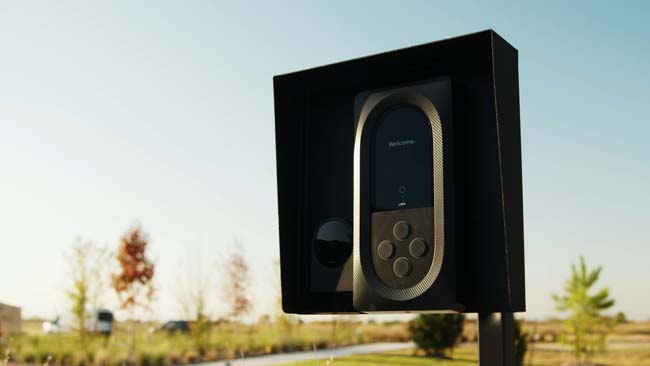Home Security: How to Choose the Right Access Control System
As anyone who has ever experienced the violation of a home or business security breach or theft can attest, the peace of mind that comes with effective accessibility control systems is essential for preserving safety and security. But how does one go about choosing the right access control system for their needs? With so many options available, navigating the world of an access control system can be complicated and overwhelming. This blog post seeks to bring the buyer a user-friendly guide that sets out the need-to-know information when it comes to making an informed decision of choosing the right access control system for your home.

Types of Access Control Systems for Home Security
When it comes to home security, the type of access control system you choose can make a huge difference in your safety. The two most common real-world systems are keypad access and secured door locks. Access with a keypad is good for people who come and go frequently or who have family members that need frequent access. Keypads provide fast, convenient entry into a home without having to carry around or temporarily assign physical keys. On the other hand, secure door locks provide an extra layer of security since they require a physical key and are hard to compromise.
It’s important to consider both types of systems when assessing the best level of security for your home. For more protection, you may want to look into controlled gate access systems that require a code plus either scanning of a personal identification number (PIN) or biometric scan, such as fingerprinting. Whatever system you decide on, there must be redundancy in the event that any one element (electrical current, mechanical lock, code sequence, etc.) fails.
No matter which type of access control system you choose, careful consideration should always be taken when selecting and implementing a home security system. With advancements made in our current technology landscape, homeowners now have more efficient and cost-effective options available than ever before – making it easy to build layers of security while reinforcing perimeter protection around your property. As we move forward in the next section and look into different types of perimeter security options, let’s put into context how essential it can be when adding these solutions to complete the comprehensive approach of ramping up your home’s safety measures.
Perimeter Security Options for Your Home
The most effective access control systems are those that can secure both internal and external spaces. Perimeter security is an important element of any home security system, as it provides the first line of defense against intruders. To protect your perimeter, there are various options available, including physical barriers such as fences, gates, and walls. For a more modern approach to perimeter security, homeowners can also invest in motion sensors, video cameras, and other types of intelligent technology that offers real-time monitoring and alerts.
When deciding which form of perimeter security to implement, homeowners should weigh factors such as cost, maintenance requirements, and local security regulations. Physical barriers like fences and walls may be more costly upfront than other solutions but could offer more complete coverage for larger properties. On the other hand, technologically advanced solutions may require less maintenance and offer more control over the environment, but they typically come with a steeper price tag. Moreover, depending on where you live, local authorities may have imposed certain regulations regarding types of fencing materials that you are allowed to use on your property.
Whether you decide to go with physical or digital means of securing your perimeter is ultimately up to you. Taking the time to consider your options will help you make an informed decision that best meets your security needs while staying within budget-guidelines. With the right combination of access control systems and perimeter security measures in place, you can rest assured that your home and family are protected from unwanted intrusions. Now let us move on to discuss how certain sensors can help identify intruders before they even enter the premises.
Main Summary Points
Access control systems can secure both internal and external areas, with the most popular perimeter security options being physical barriers such as fencing or walls, or digital means of security such as motion sensors and video cameras. Homeowners should consider cost, maintenance requirements, and local regulations when deciding how to set up their perimeter security. With proper access control systems and perimeter security in place, homeowners can ensure their home and family are safe from unwanted intrusions. Sensors can help preemptively identify intruders before they enter the premises.
Sensors to Monitor Intruders
Now that we’ve talked about perimeter security options for your home, let’s consider the importance of sensors to monitor intruders. For individuals concerned about home safety, sensor systems are a great way to detect an intruder before they enter. Many sensor systems feature wide-range motion detection that instantly alerts you if someone is on your property. Additionally, some advanced systems also have facial recognition technology and thermal heat signatures that instantly sends an alert to the housing authority when motion is detected.
However, it’s important to evaluate different sensor systems on the market according to their features and functionality. You may opt for motion-detection cameras with night vision capability or even infra-red scanners integrated into the sensor system itself to detect intruders in total darkness. No matter what type of sensor system you choose, it will provide you much needed peace of mind knowing that your home is protected.
Ultimately, having a good security system with durable sensors can help guard against any unwelcome activity near your property and make sure your home is secure against possible intrusions. With the right security system in place, you can rest assured that potential burglars won’t be able to breach your perimeter without detection.
Locking Down the Perimeter with Key and Password Entry
Now that you know how sensors can help you monitor potential intruders and secure your home against them, it’s time to look at what methods of entry you should use. One commonly employed option is key and password entry. Keyed entry is a great way to ensure that only people with physical access to the key can gain entry into your home and potentially protect against forced or pick entry lock systems. For an added layer of security, many homeowners are now electing to use keypads in combination with a physical key. This allows for ease of entry, promoting convenience while still ensuring security.
This approach also allows family members or frequent visitors to have their own individual code they need to use when entering the home, allowing you to keep track of those who are coming in and out as well as setting limits on certain user types if desired. While this form of access control does add an extra layer of security compared to just having a physical key, it can be vulnerable against techniques such as shoulder surfing where someone looks over an unsuspecting user’s shoulder while they punch in their entry code. To counter this potential attack vector, some companies offer solutions designed with obscured keypads so passers-by cannot make out which keys have been pressed.
Overall, giving users the ability to enter their home via key and/or password does provide additional safety and convenience for the homeowner. However, since there are still ways to breach this kind of system, it’s important not to rely on it as the only line of defense when looking into home security systems.
Choosing Between Access Control System and Alarm Systems
Once the perimeter of your home or business is secure with a key and password entry system, it’s time to consider access control and alarm systems for the next level of protection. Both of these access controls allow for restricted areas to be set up with logs of who goes in and out and when. They also both offer various methods of authentication such as PIN codes, key fobs, and biometric systems.
When choosing between access control and alarm systems for your home or business, there are several factors to consider. With an alarm system, it doubles as an alert system to notify authorities when a breach has occurred. It also offers rapid response as it can provide early detection which can help responders apprehend criminals before they make it past the security perimeter. Alternatively, an access control system monitors both people entering and leaving any restricted area but doesn’t necessarily alert authorities when a breach occurs.
However, the upside of investing in an access control system is that it allows facility managers to gain greater visibility into those coming and going on their premises. Depending on the type of access control setup installed, businesses often find that they’re able to reduce high costs associated with employee theft by keeping better track of who enters certain rooms or buildings – especially warehouses or maintenance areas. Access control setups can also document time-in/time-out records used for compliance reporting requirements. Additionally, controlled access provides an extra layer of comfort when visitors come onto the premises as there isn’t any risk of them finding their way unauthorized into employee break rooms, secured lobbies and other areas off-limits to guests.
Ultimately, the best choice for any workplace depends on its unique requirements which should be weighed against budget constraints. Factoring in all of these considerations will help ensure that you get precisely the solution needed for protected entryway solutions.
To build on this added protection for your home or business, you may want to consider optional accessories for your access control system like gate arms, telephone entries and card readers. These components can expand and personalize the features on a home security monitor or commercial video surveillance system set up making managing doorways even easier while still offering complete discretion against potential intruders.
Optional Access Control System Components
Access control systems are a powerful tool for creating a secure perimeter, making it essential to understand which components and features are available as part of a system. While alarm systems might provide more visibility into an intrusion, access control systems can offer far more advanced tools for preventing unauthorized access. With additional elements like proximity readers, keypads, intercoms, and biometrics, users have greater levels of security control with access control systems.
Proximity readers allow users to enter and exit buildings without having to manually scan physical cards or keys, and in some cases may be integrated with biometric scanners for even greater security. Keypads are also commonplace for controlling who has access to the building but should be used carefully so that codes aren’t shared. Intercoms are useful for controlling entry of individuals into high-security areas and may integrate with gates or barriers for restricting access to restricted areas. Biometric technology taking the form of fingerprint and facial recognition scanners is also popular as a means of verifying whether someone should be allowed access.
No two access control needs are the same, so it’s important to analyze what components your system will need prior to installation. By combining multiple security measures, businesses can create an effective defense against unauthorized personnel while still providing convenient access when needed.
While alarm systems and access control solutions can both provide beneficial security solutions, it’s important to consider each in conjunction with one another to maximize protection. For example, by combining an access control system with cameras and sensors, businesses can quickly identify threats while providing verifiable evidence when perpetrators need to be tracked down.
RFID and Biometrics Devices
As we shift from cameras and sensors to the next form of access control, RFID (Radio-Frequency Identification) and biometrics devices come to mind. These devices use modern technology to help homeowners protect their assets without having to rely on manual methods.
RFID devices are small secure tags that emit a signal which can be detected by an RFID reader. They can be attached to items or placed around the home, linking them to the owner’s secure ID system. Biometrics, such as fingerprint-, iris- and facial recognition scanners, are another option for keeping a home safe. These systems use computer algorithms to ensure only authorized people can enter a home.
Both forms of access control have benefits that should be weighed prior to purchase. Proponents of RFID systems argue its flexibility allows it to fit into most security plans; the cost savings make it attractive for larger projects; and it is an easy way for managing databases of users and intruder activity. Those who favor biometric systems laud its accuracy in identifying true users, its ability to provide automated detection of unauthorized entry attempts, and how fast it can complete authentication steps.
In making the decision between RFID or biometric access control systems, it is important that homeowners consider their budget and preferences as well as investigate other features available with each type of access control system before making a purchase. The decision should also take into account future needs so that the homeowner chooses an access control system that can scale with their changing security requirements over time.
How to Choose the Right Access Control System for Your Home
Choosing the right access control system for your home is a critical decision that should not be taken lightly. There are a variety of different types of systems available, so it’s important to do your research and understand the pros and cons of each access control system before making a decision. Of these, RFID (Radio Frequency Identification) and biometrics devices are two popular choices among homeowners today.
RFID systems use small, chip-like readers and tags to grant or deny access. The chips contain identification information and data stored in them which can be read by the reader. This type of security system provides convenience and peace of mind for homeowners as it does not require them to remember codes or keys; all they have to do is present the chip-containing tag or key fob for entry. Furthermore, RFID systems are relatively easy to install, especially when compared to biometric systems. However, RFID systems can be vulnerable to tampering; if an intruder has access to one tag, they could potentially program other tags with the same code or information which would allow them entry without authorization.
Biometric systems are becoming more popular as a way to ensure secure access control in homes because they rely on physical traits rather than codes or combinations. These systems use technologies such as finger printing, facial recognition, and retinal scanning identification in order to verify identity and grant or deny entry. This makes them highly secure; since no two people have the same exact physical characteristics, accessing the home without authorization is nearly impossible. Additionally, biometric systems generally cost more than RFID systems; installation can also be complicated due to the intricate wiring required for fingerprint readers and cameras. As such, installation may require professional assistance and additional costs may be associated with this service.
When deciding on which access control system to choose for your home it is important to consider the pros and cons of both types; evaluate the tradeoff between initial cost savings with an RFID system versus long-term security with a biometrics system. Ultimately, it comes down to what level of security you’re comfortable paying for as well as how much effort you want to invest in regularly updating codes on an RFID system versus having a more permanent solution such as biometrics. Weighing your options carefully will ensure you find the best system for your needs.








